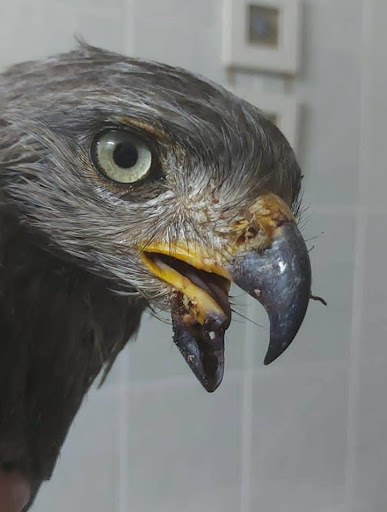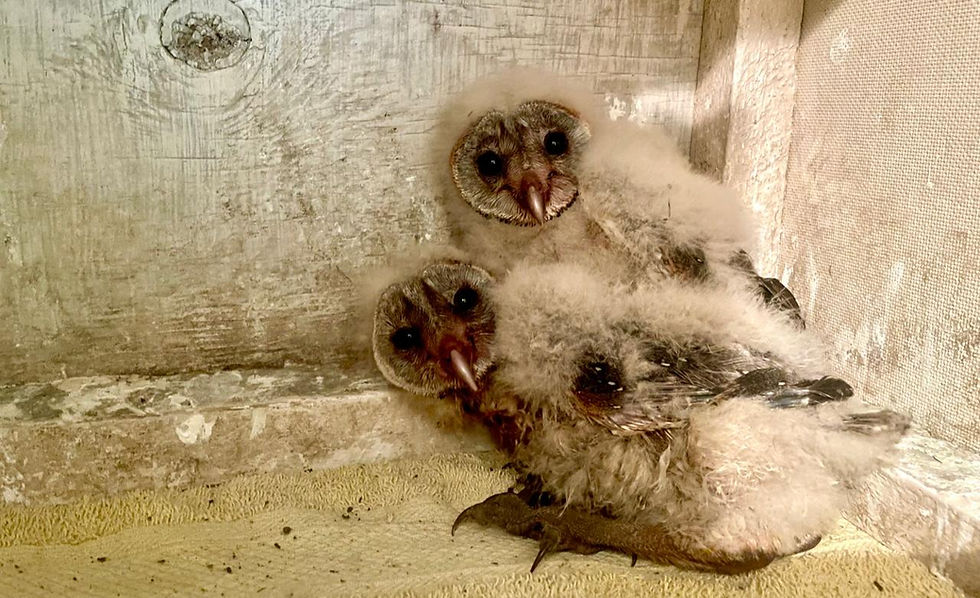Fixing a Southern Banded Snake Eagle’s broken jaw
- Simon Thomsett

- Jan 3, 2024
- 3 min read
Updated: Mar 16, 2024
On 7 December 2023 Dr Juliet Waiyaki, Mwanzia and I operated on two eagles. One a Tawny Eagle that had come from the Mara with a shattered wing that had mud crushed into its bones. The other was a Southern Banded Snake Eagle, an obscure species I had never handled previously.
This eagle made a stir at the coast after being found in a septic tank with a broken lower jaw. It was
found by Primate Global Foundation at Gede National Monument. KWS Watamu Marine and A Rocha Kenya assisted in the rescue and brought the eagle to Roy Bealey for its temporary care. It had been found in a septic tank and rescued by the Gede guides. It’s jaw was badly broken and we were lucky to resolve it.
We used tiny needle stents as miniature facio-maxillary plates. This was an old trick I used to fix tiny birds (such as the leg of a Pied Wagtail) or tiny bones on bigger hawks. This procedure requires dexterous ability to feed a thin wire down the middle of a hypodermic syringe needle. The kind of needle one uses to inject medicine. Once you have mastered this you can screw these needles into tissue and bone, come out the other end, feed the wire into the needle and then retreat the needle the way it came in, using it as a guide to pull through the wire. Often surgery is messy and frequently a lot of it is done by feel. Making holes is easy, but finding the holes with a thin piece of wire is near impossible. By using a needle as a guide the thought struck me that one can make a cradle of needles supported by internal wires. This bracing system I think is our own Jua Kali resourceful solution to tiny fractures. I haven’t heard of its use elsewhere.
The picture of the right side of the jaw shows the method used to stabilise the fracture clearly. The needle is passed through the 2.5mm bone and the cerclage wire inserted inside and drawn through, then the needle itself is cut to form a splint. We used two splints placed 90 degrees to each other. When tightened the bones come into perfect apposition which is needed as the separation of the keratin part of the bill normally does not bode well. The same on the left jaw, except it needed to have the needles placed inside the skin on either side of the fracture next to the bone. The left side of the jaw was more challenging as this needed to be re-broken, aligned under tension and have bone autografts pushed in as wedges to get the correct
angle.
Unfortunately most hypodermic needles are not stainless steel, and the cerclage wire used was very thin jewellery wire. When two different metals are put together (especially in a slightly saline solution, such as blood), a small electrical current is expected. This does not encourage healing and so it cannot remain inside the body for long. Three weeks minimum is needed for bone healing, but two weeks may lead to metal sensitivity and problems. The trouble was that both sides of the jaw needed to be broken and these had to be done separately. If done together, the first time it bit down on food would see the whole jaw break. Fortunately the eagle was very placid and would eat its food cut in small pieces without putting pressure on the fractures. Reactive and rapid bone growth, perhaps spurred by the metal sensitivity, occurred and after three weeks the needles, pins and wires were all removed. Raptors must have perfect alignment of lower jaw to upper jaw as they abrade each other and keep the beak tips in the right shape. If out of alignment even by a fraction, the bill grows in a distorted way leading to the inability to feed. We crossed our fingers as the last brace came off.
We had named the eagle Ngala after one of the coast’s most prominent forest conservationists David Ngala who died in a tragic accident. Ngala, the eagle is fast recovering with a fine looking jaw. He stares right at you looking stern and in perfect symmetry. The operations were a success!

Ngala will be returned to his coastal forest, to the very same people that saved his life, and to his own territory. There he will be monitored and followed to make sure he will survive.
Wish to learn more, subscribe to our newsletter and follow us on Facebook and Instagram.














Comments